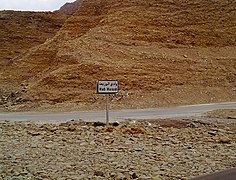|
Wadi Wurayah
 Wadi Wurayah (Arabic: وَادِي ٱلْوُرَيْعَة, romanized: Wādī Al-Wurayʿah) is a 12,700-hectare (31,000-acre) wadi between the towns of Masafi, Khor Fakkan, and Bidiyah in the United Arab Emirates. It has been designated as Ramsar Wetland of International Importance.[3] The lush canyon in the area was named after the tall marsh plant known as ‘warrah’, that flourishes in its wetlands, while the word ‘wadi’ is the Arabic term for valley.[4] Protected areaOn 16 March 2009, the Wadi Wurayah became the first protected mountain area in the United Arab Emirates, after a three-year campaign by the Emirates Wildlife Society in Association with World Wide Fund for Nature,[5] with the support of HSBC Bank Middle East Limited.[6] In addition to the conservation of the area's delicate ecosystem, EWS-WWF have also set up camera traps to photograph the more elusive wildlife, and arranged field trips for students to help raise awareness of the area.[7] Flora and fauna Wadi Wurayah is home to more than 100 species of mammals, birds, reptiles and amphibians, as well as more than 300 species of plants. It is famous for its scenic waterfall set amid the Hajar Mountains. It has streams and pools dotted around the rocky outcrops. It is one of few remaining places in the world where the endangered Arabian tahr still roams free.[8][9] Conservationists believe it to be among the last places in the UAE where the Arabian leopard, which has not been seen in the UAE since 1995, still survives. A footprint of a leopard was found here.[10] The same is true for the caracal. The wadi is also home to the Garra barreimiae, a type of freshwater fish that lives only in Al Hajar Mountains. Among the 208 species of plants is a species of wild orchid unique to the area, the Epipactis veratrifolia.[11] In 2018, an Indian crested porcupine was spotted here.[12][13] In January 2020, a few Indian fritillaries (Argynnis hyperbius) were found in the park by Binish Roobas, an Indian naturalist based in the UAE, who photographed a male and female. He was visiting the area to survey the diversity of flora and insects, after heavy rainfall in the country from October 2019 to January 2020, along with park ranger Sami Ullah Majeed, biologist Nuri Asmita, and the Chairman of the Dubai Natural History Group, Gary Feulner. It was thought that the fritillaries, which were found flying with members of a physically similar species, the plain tiger (Danaus chrysippus), came here as opportunistic migrants because of the rainfall and would not stay during the summer.[14][15] Gallery
See also
References
External links |
||||||||||||||||||||||||||






